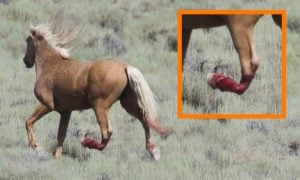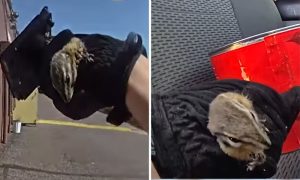Dog guardians, be aware: The area where you are living likely has laws that could get your precious companion confined for life — or worse.
The specific provisions of “dangerous dog” laws vary across states, and even cities within states. While the words “dangerous dog” might bring to mind a probably abused dog who has a history of biting people, dangerous dog ordinances often are vaguely-worded laws that catch many unsuspecting canines – and their families — in their net.
The consequences can be serious — including lifelong confinement, relocation from a guardian’s home, or even county-ordered death for the dog. The laws can apply equally to dogs who have histories of biting, dogs who have never bitten anyone, and friendly dogs who escape accidentally from their families’ homes and are on the loose.
Here’s a quick run down of five ways you can keep your dog safe from dangerous dog laws. To learn more about dangerous dog ordinances, please read Lady Freethinker’s full story here.
1. Love your dog and be a responsible guardian.
The American Veterinary Medical Association recommends that people take the following steps to minimize the chances that a companion dog will act aggressively:
- Make sure to socialize your dog and take training classes if needed.
- Ensure your dog is spayed or neutered and gets daily, adequate exercise.
- Educate yourself and family members (especially children) about how and when to approach a dog, to first obtain the dog guardian’s permission to pet or touch the dog, and to learn basic signals of dog body language.
- Avoid risky situations, including touching dogs who are sleeping or eating, being in the same area as a loose or unattended dog, and staying away from a leashed dog if the dog’s guardian tells you the dog doesn’t do well with other animals or does not give you permission to pet the dog.
2. Educate yourself about “Dangerous Dog” laws.
Dangerous dog laws vary, but some of the behaviors that most commonly get a dog in trouble, including in both public settings or on private property:
- “Aggressive” behavior — defined most commonly as biting, causing serious injury, or killing a person, but also including growling or approaching in a “menacing” manner
- Proven history of killing another animal — including cats, chickens, or other dogs
- Dogs on the loose, including those who accidentally escape from homes or yards
- Dogs who chase people — including cyclists or mail carriers — when unprovoked
- Discriminatory actions against certain breeds, or cities with breed bans — most commonly impacting pit bulls, bull terriers, Alaskan Malamutes, Chow Chows, Rottweilers, and German Shepherds, to name just a few
3. Specifically research “dangerous dog laws” covering your area.
It’s extremely important to know what dangerous dog ordinances are in place within your state AND within your city:
- You can start by searching “dangerous dog ordinances (name of your city/state)” or “animal control ordinances (name of your city/state).”
- Reach out to your city officials or your county commission and ask for a copy of the dangerous dog ordinance or animal control codes.
- Be sure to also search for “breed specific legislation (name of your city)” to see if your area is one that allows rules that discriminate based on breed, rather than behavior. The Michigan State University Animal Legal and Historical Center has a fantastic guide to specific breeds (unfortunately) banned by city and state here.
4. If your dog has been labeled as “dangerous,” prepare for a long legal battle.
Typically what happens following a dog bite is that some kind of investigating authority — such as police or animal control officers — will evaluate and present evidence to a hearing examiner, who then makes a determination about whether the dog meets “dangerous dog” criteria.
The dog’s guardian can then decide to appeal that decision within a certain time frame and most commonly with the help of an attorney. The dog typically will be impounded by the investigating agency, with the dog’s owner picking up the costs, while the case remains open.
Appeals often get denied, and an attorney will then need to take the case to additional appellate courts. Families should be prepared for a lengthy legal battle to ensue. Getting kill orders reversed, as well as getting the “dangerous dog” labels dropped, took an average of up to two years, according to the cases reviewed by LFT.
5. Be ready to offer solutions that will save your dog and address public safety concerns.
Always keep your dog’s best interest at heart.
Courts that allow dogs officially labeled as “dangerous” to remain with their families typically impose a series of conditions, which can include microchipping, sterilization, confinement to the home or a locked outdoor kennel, signage that a dangerous dog is on the property, leashing and muzzling, an annual registration fee, and obtaining a bond or insurance of up to $250,000.
Some courts, however, will instead banish the dog from the area or order for the dog to be killed. Attorneys who spoke with Lady Freethinker said that many judges don’t want to order dogs to be killed but that solutions often require the dog to never again return to the family.
Please know that guardians who choose to ignore the court-imposed conditions can face criminal charges, confiscation of the dog, and serious fines.
6. Always keep your dog on a leash, and make sure he or she is wearing a visible sign of belonging, such as a collar.
An officer who shot and killed a reportedly friendly companion animal noted in his interview that the dog was running loose and was not wearing a collar. An investigative report into the tragic killing noted that officers who perceive unleashed dogs running “at-large” and not wearing collars can be classified more as a “public nuisance” than a beloved pet, and many state laws allow for the killing of animals in those situations. Please keep your pet as safe as possible at all times by keeping them leashed on walks and pick out a collar for them to wear to immediately signal to law enforcement or any one else that yours is a loved companion animal.
For more information, please read Lady Freethinker’s full story here.







